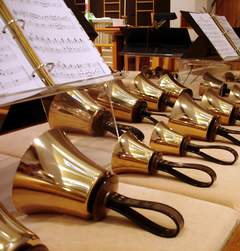|
Handbells can fulfill several important functions: development of individuals’ musical skills, encouragement of teamwork, socialization and self-esteem, and expansion of the music program.
Teachers can readily address rhythm, dynamics, key signatures, and notation in a group setting with handbells, and over time teach everything from duration and loudness to timbre, texture, and style. Handbells also teach individuals the importance of group cooperation and team spirit, an important concept in any ensemble program. The very nature of a handbell choir requires individuals to work together if their instruments are to make music. Participation in a handbell program can also help build confidence and self-esteem for those who have difficulty finding achievement elsewhere. Since handbells are easy to play, success can come quickly--even to those not particularly gifted, either musically, artistically, or academically. What’s more, it can provide the pleasures and commitment of a musical ensemble experience to students who have not invested years in learning more traditional band and orchestra instruments. Perhaps most important, the flexibility and growth inherent in a handbell program lets students begin at the beginning and progress as far as they might desire. Handbells can also fulfill at least two important objectives: the educational objective of challenging individuals with a limitless range of ever more demanding arrangements, and the performance objective of presenting magnificent music to public audiences. As such, a performing choir can help any institution establish and maintain a visible presence in its community--not just by staging concerts within the facility itself, but by reaching out to those in nursing homes, hospitals, shopping malls and other public venues. |
- Calendar
- Events
-
Media
- Rehearsal Recordings
- Photos
-
Concert Recordings
>
- 2022 - 2023 Concert Recordings >
- 2021 - 2022 Concert Recordings
- 2020 - 2021 Concert Recordings
- 2019 - 2020 Concert Recordings >
- 2018 - 2019 Concert Recordings >
- 2017 - 2018 Concert Recordings >
- 2016 - 2017 Concert Recordings >
- 2015 - 2016 Concert Recordings >
-
2014 - 2015 Concert Recordings
>
- State Choir, May 16, 2015
- Spring Concert, May 13, 2015
- Combined with DSU at Eccles, April 29, 2015
- State Solo and Ensemble, April 25, 2015
- Festivals Concert, April 22, 2015
- Region Large Choir, April 8, 2015
- Region Solo and Ensemble -- March 18, 2015
- Combined with MMHS at Eccels March 25, 2015
- Take Note! January 28, 2015
- Christmas Concert Dec. 3 2014
- Fall Concert 2014 (High School)
- Fall Concert 2014 (Middle School)
-
2013 - 2014 Concert Recordings
>
- Graduation May 22, 2014
- CA Trip National Anthem April 12, 2014
- State Large Choir May 9, 2014
- State Solo & Ensemble April 26 2014
- DSU Ladies Choir Festival April 1, 2014
- Region Large Choir 2014
- Green Valley Chamber Invitational March 21, 2014
- Take Note Concert, January 31, 2014
- Washington All-County Honor Choir 2014
- 2013 Christmas Concert
- The King and I PVHS Live Cast Recording 2013
- 2013 Fall Concert
- 2012 - 2013 Concert Recordings >
- 2011 - 2012 Concert Recordings >
- Past CD Recordings >
- Utah All-State and Honor Choir Recordings >
-
The Choirs
- Class Sites
- Awards and Progress
- About Us / Contact Us
-
Resources
- What's New?
- SUPAF Choir (February 11, 2020)




